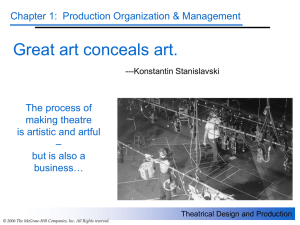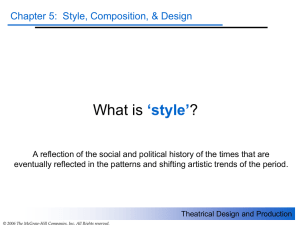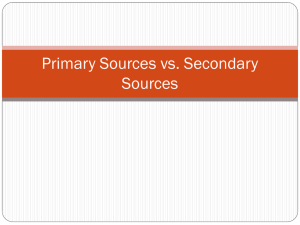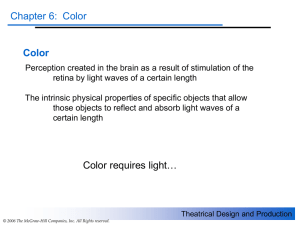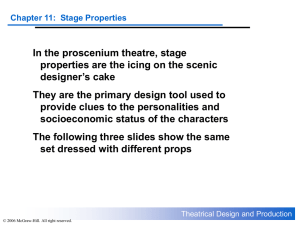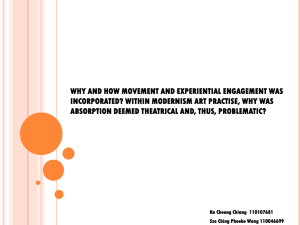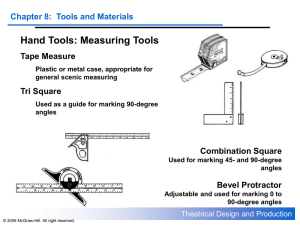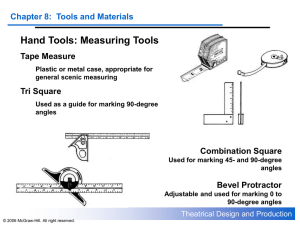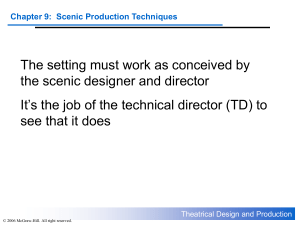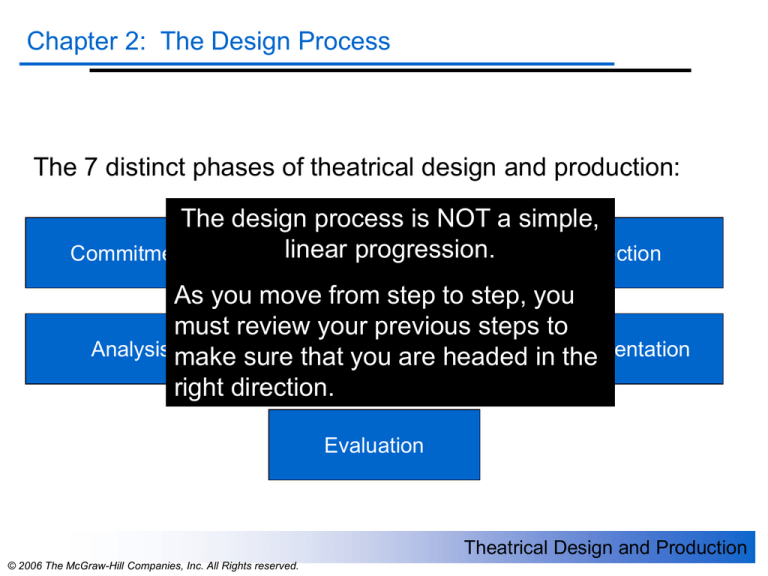
Chapter 2: The Design Process
The 7 distinct phases of theatrical design and production:
The design process is NOT a simple,
linearResearch
progression.
Commitment
Selection
As you move from step to step, you
must review your previous steps to
Analysis make sure that
Incubation
you are headed inImplementation
the
right direction.
Evaluation
Theatrical Design and Production
© 2006 The McGraw-Hill Companies, Inc. All Rights reserved.
Chapter 2: The Design Process
Commitment
Wholeheartedly commit to doing your best work
Use the word problem as infrequently as possible;
instead, use challenge
•A challenge is more interesting and more
manageable than a problem
Theatrical Design and Production
© 2006 The McGraw-Hill Companies, Inc. All Rights reserved.
Chapter 2: The Design Process
Analysis
This step in the process has two objectives:
Gathering information that will help
clarify and refine
the definition of the challenge you are facing
Identifying areas that will require further research
Theatrical Design and Production
© 2006 The McGraw-Hill Companies, Inc. All Rights reserved.
Chapter 2: The Design Process
Analysis, cont.
Prime sources of information include the script, the producer,
the director, and your fellow designers
Examine every aspect relevant to your design project
Stream-of-consciousness questioning
Ask the questions that pop into your head as soon as they pop into your head!
Read the script.
Some designers read it before meeting with other members of the production
team; others wait until after. Both approaches are valid, and it comes down to
personal choice
Theatrical Design and Production
© 2006 The McGraw-Hill Companies, Inc. All Rights reserved.
Chapter 2: The Design Process
Analysis, cont.
Analyzing the script—“the first three readings”
First Reading: The first time you sit down with the script
Read it for fun; discover the play’s “flavor”
Learn: general storyline, the nature of the characters, and the relationships
Italicized design information are not requirements but suggestions
Use that information to synthesize an original design concept
Theatrical Design and Production
© 2006 The McGraw-Hill Companies, Inc. All Rights reserved.
Chapter 2: The Design Process
Analysis, cont.
Analyzing the script—“the first three readings”
Second Reading
Look for specific moments and incidents within the play that stimulate your imagination
•These moments will provide you with strong visual and textural images and
feelings
Carry a notebook with you to jot down inspirations
Don’t judge the ideas at this point; gather information now, weed later
Theatrical Design and Production
© 2006 The McGraw-Hill Companies, Inc. All Rights reserved.
Chapter 2: The Design Process
Analysis, cont.
Analyzing the script—“the first three readings”
Third Reading
Look for specific mechanical information rather than broadly based concepts
Note information that affects the time and financial budgets
•That information could include special props, construction, costumes, or
effects that will require extra time and/or money
Information from the “third reading” comes not only from reading the script, but also from
conferences with other members of the production design team
Theatrical Design and Production
© 2006 The McGraw-Hill Companies, Inc. All Rights reserved.
Chapter 2: The Design Process
Analysis, cont.
SHED YOUR FEAR!
In order to analyze effectively, you must shed your fears of
criticism, making mistakes, and appearing less than
brilliant or foolish
Fear inhibits thinking
The only dumb question is the one that isn’t asked
Theatrical Design and Production
© 2006 The McGraw-Hill Companies, Inc. All Rights reserved.
Chapter 2: The Design Process
Remember
Research
Past productions should be used as
references
Resist the temptation to copy another
designer’s work.
Background Research
It will stifle your creativity, and it is
ILLEGAL.
Designers must study the historical background of each production they
design
Online research can be quick and helpful, but it may not always be
detailed. Don’t forget about the library!
Research may include visiting museums to get a sense of an historical
period
Research may include reading about past productions
Theatrical Design and Production
© 2006 The McGraw-Hill Companies, Inc. All Rights reserved.
Chapter 2: The Design Process
Research, cont.
Conceptual Research
This type of research involves devising multiple solutions to specific
design challenges
Avoid the “perceptual block”; try to come up with more than two or three
solutions
Theatrical Design and Production
© 2006 The McGraw-Hill Companies, Inc. All Rights reserved.
Chapter 2: The Design Process
Incubation
“Sleeping on it”: Give yourself the needed time and stress reduction to allow
the solutions to float from your subconscious to your consciousness
Incubation provides you with time to let ideas hatch
“Enough time” can be anywhere from a few hours to several days depending
on the size and scope of the project
Don’t procrastinate!
You will do your best work when you
allow time for incubation
Theatrical Design and Production
© 2006 The McGraw-Hill Companies, Inc. All Rights reserved.
Chapter 2: The Design Process
Selection
Selection involves sifting through all of the data you have accumulated
and deciding on your specific design concept
Every designer’s designs for a production should be discussed in a
production meeting in order to maintain unity of vision
Depending on which aspect of the production you are designing, there are
various ways to convey your concept at this stage of the design process
Theatrical Design and Production
© 2006 The McGraw-Hill Companies, Inc. All Rights reserved.
Chapter 2: The Design Process
Thumbnail sketch
Selection, cont.
a small, quick, rough drawing, usually in pencil
Scenic Designer
Draws thumbnail sketches
to explain the scenic
concepts for the production
Constructs functional
models to more fully explain
the concept.
Can create a “virtual model” Functional model
of the concept using
a 3-dimensional
computer technology
sketch of the
Provides an indication of
intended color scheme
design built on a ½
or ¼ to 1 ft. scale
Theatrical Design and Production
© 2006 The McGraw-Hill Companies, Inc. All Rights reserved.
Chapter 2: The Design Process
Selection, cont.
Costume Designer
Provides hand- or computerdrawn sketches or pictures of the
intended costumes
Although the costume designer
will attach fabric swatches to the
final renderings, only an
indication of color and fabric
need be on these initial sketches
Theatrical Design and Production
© 2006 The McGraw-Hill Companies, Inc. All Rights reserved.
Chapter 2: The Design Process
Selection, cont.
Lighting Designer
Submits sketches or computer
presentations showing the general
characteristics of the lighting concept
At the least, the lighting designer
presents the intended palette and verbal
description of the atmospheric effect of
the lighting
Theatrical Design and Production
© 2006 The McGraw-Hill Companies, Inc. All Rights reserved.
Chapter 2: The Design Process
Selection, cont.
Sound Designer
Discusses the sound scoring—the types of background and
specific sound and musical effects
Also discusses the location of the various speakers’ setups
Theatrical Design and Production
© 2006 The McGraw-Hill Companies, Inc. All Rights reserved.
Chapter 2: The Design Process
Implementation
This phase begins when you stop planning and start doing
At this time, all designers must provide the
necessary drawings, models, plans, and
instructions to construct the designs
Theatrical Design and Production
© 2006 The McGraw-Hill Companies, Inc. All Rights reserved.
Chapter 2: The Design Process
Implementation, cont.
A production model is similar to a functional model
except that it is fully painted and complete with furniture
and props
Scenic Designer
Makes the final color
renderings of each set and
constructs (if necessary)
production models
Drafts the plans that describe,
to scale, all the details of how
the set should look
Monitors the progress of
construction of sets and
properties
Theatrical Design and Production
© 2006 The McGraw-Hill Companies, Inc. All Rights reserved.
Chapter 2: The Design Process
Implementation, cont.
Lighting Designer
Draws the light plot as well as
the other paperwork
associated with lighting
design
Supervises the hanging and
focusing of the lights and
determines the intensity
levels and timing of all
lighting cues
Theatrical Design and Production
© 2006 The McGraw-Hill Companies, Inc. All Rights reserved.
Chapter 2: The Design Process
Implementation, cont.
Costume Designer
Produces colored renderings for
each costume, complete with
notes and sketches that fully
describe the accessories, general
style, period, and feeling of the
costume
Turns over fabric samples and trim
to the costume shop
Maintains close contact with the
shop
Theatrical Design and Production
© 2006 The McGraw-Hill Companies, Inc. All Rights reserved.
Chapter 2: The Design Process
Implementation, cont.
Sound Designer
A sound plot is a list
describing each sound
cue in the production
Completes the sound plot
Begins gathering and recording the various musical and effects cues
Assembles the necessary playback equipment and speaker systems
During the tech and dress rehearsals, determines the appropriate
loudness levels for each cue
Theatrical Design and Production
© 2006 The McGraw-Hill Companies, Inc. All Rights reserved.
Chapter 2: The Design Process
Implementation, cont.
At this time, the technical
director:
Completes the production calendar
Minor changes may
be made as the
director begins
to see the production
coming together; production
meetings during this phase
can help ensure that
the lines of communication
stay open
Makes any necessary construction drawings
Orders the materials for construction, organizes the crews
Begins construction
Theatrical Design and Production
© 2006 The McGraw-Hill Companies, Inc. All Rights reserved.
Chapter 2: The Design Process
Evaluation
Evaluation takes place within each step of the design process, and it
also occurs when the project is completed
The final review should be an examination of the methods and
materials used to reach the final design goal
Designers should not only objectively evaluate their own designs,
but also the process of communication throughout the production
period
Theatrical Design and Production
© 2006 The McGraw-Hill Companies, Inc. All Rights reserved.

